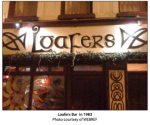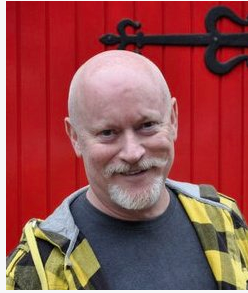 Written by Orla Egan
Written by Orla Egan
Loafers Bar was opened in 1983 by Derrick Gerety and his then partner Seamus Hogan. Loafers Bar, on Douglas Street in Cork, is still open today making it the longest running gay bar in Ireland.
Loafers was not opened specifically as a gay bar, and in the early years in particular, there was a mixed (gay/straight) clientele. It became an important social meeting space for lesbians and gays as well as for people involved in ‘alternative’ groups and lifestyles in the city and for those involved in the Quay Co-op.
Explaining his reasons for  opening the bar Derrick comments: “I just wanted to have a bar where I felt comfortable myself. Not necessarily a gay bar, that wasn’t the plan, but a bar that was new but kept old style elements. We played good music, sold bottled beers like Becks and Stella Artois, sold gallons of tequila and orange, and all for a reasonable price. So we got loads of art students, funky stylish kids and, of course, gays. It was about 50/50 gay/straight in the beginning. Quite an atmosphere for the early 80s in Cork.” (Conversation with Derrick Gerety 2014)
opening the bar Derrick comments: “I just wanted to have a bar where I felt comfortable myself. Not necessarily a gay bar, that wasn’t the plan, but a bar that was new but kept old style elements. We played good music, sold bottled beers like Becks and Stella Artois, sold gallons of tequila and orange, and all for a reasonable price. So we got loads of art students, funky stylish kids and, of course, gays. It was about 50/50 gay/straight in the beginning. Quite an atmosphere for the early 80s in Cork.” (Conversation with Derrick Gerety 2014)
Derrick continued to run Loafers for 16 years years and saw it develop into a primarily gay bar which provided an important public venue for the Cork LGBT community.
Having a public social venue was very important for the development of the Cork LGBT community. This public space, and the contact and social interaction it facilitated, was an important element in the building of contacts, connections and elements of community. In 1992 Munster LGCN described Loafers as “an institution on the Irish lesbian and gay scene” which “has provided an invaluable, safe and welcoming meeting-place for the community down through the years.” (“Profile: Derrick Gerety” in Munster LGCN December 1992 / January 1993)
In their study of lesbian bar culture in Buffalo in the 1930s and 1940s, Lapovsky Kennedy and Davis note the importance of bars in terms of lesbian community and resistance: “By finding ways to socialize together, individuals ended the crushing isolation of lesbian oppression and created the possibility of group consciousness and activity. In addition, by forming community in a public setting outside of the protected and restricted boundaries of their own living rooms, lesbians also began the struggle for public recognition and acceptance.” (Elizabeth Lapovsky Kennedy and Madeline D. Davis “‘I Could Hardly Wait to Get Back to that Bar’ Lesbian Bar Culture in Buffalo in the 1930s and 1940s” in Creating a Place for Ourselves: Lesbian, Gay and Bisexual Community Histories Edited by Brett Beenyn; Routledge; New York and London; 1997; p. 27)
See the post on Lesbian Activism Cork 1980s for a discussion of the origins of the Thursday night women’s night in Loafers. See also the Out and About film for footage and discussion of Loafers.
The Cork Folklore Project have included an interview with Derrick Gerety about Loafers Bar in the 2013 Issue 17 of The Archive.

Pingback: 1980s Social Venues | Cork LGBT History
Pingback: Loafers Bar Closes Down | Cork LGBT History